Whether you’re aiming to bake pizza yourself or simply love eating it, getting to know the various kinds is both fun and interesting. Let’s get started!
A Brief History of Pizza
What exactly is pizza? Well, pizza, like Torta Caprese, is from Italy. It is a round and flat, wheat-based dough topped with tomatoes, cheese, and other ingredients, and baked until the pizza crust is crispy and golden, and the cheese is bubbly and melted to perfection. But how exactly did it come to be?
According to Peatzeria, pizza evolved from flatbreads sold by street vendors in the late 18th century. The vendors topped with garlic, salt, herbs, lard, cheese, and other ingredients. They sold them primarily to low-paid workers seeking convenient and satisfying food.
Thankfully, in 1889 King Umberto I and Queen Margherita of Italy were impressed by a pizza topped with basil, mozzarella, and tomatoes, created by Raffaele Esposito to reflect the colors of the Italian flag. This pizza, known as the Margherita, gained royal approval. It also marked a significant moment in pizza history, making it go from street food to popular fare.
And in the 20th century, pizza gained popularity worldwide, especially in America. It became a favorite among Allied troops during World War II and later spread as Italians migrated to other countries and international travel became more common. This is also when different styles of pizza started popping up.
What are the different styles of pizza, exactly? Well, on to the main section of this article!
A Quick Disclaimer
This list doesn’t represent all different kinds of pizza. It’s just a taste of what we feel are some of the most popular and interesting kinds. We hope it gets you excited to try new pizzas and explore more on your own.
Here are some of the different kinds of pizzas you should make!
Different Kinds of Pizzas to Make 1: Margherita Pizza

Margherita pizza, a kind of tomato pizza, is one of the oldest flavors of pizza. It’s a classic Italian pizza composed of a thin crust topped with tomato sauce, fresh mozzarella cheese, basil leaves, a drizzle of olive oil, and a sprinkle of salt.
It’s simple, light, and possibly the purest form of pizza you’ll ever taste. Hey, it was approved by royalty, so it’s definitely good enough for all of us!
Different Kinds of Pizzas to Make 2: Pepperoni Pizza

Pepperoni pizza is one of the most popular pizzas in the United States—according to a 2017 Harris Poll, 36% of Americans prefer pepperoni on their pizza above all other toppings! It’s not hard to imagine why. The combination of a crispy crust, tangy tomato sauce, gooey mozzarella cheese, and the spicy kick of pepperoni slices creates a perfect balance of flavors and textures that many find irresistible.
The flavor appeal actually extends to the rest of the world. We’re sure you’d agree that pepperoni pizza is one of the most recognizable pizzas in the world.
Oh, and fun fact? Pepperoni pizza is not from Italy—this pizza is more of an Eastern European/American-Italian version.
Different Kinds of Pizzas to Make 3: Hawaiian Pizza

With all kinds of pizza toppings, how could anyone have thought of putting pineapple on pizza? Hawaiian pizza, which mixes sweet and savory tastes, is a bit of a debate starter. It usually has a thin crust with tomato sauce, mozzarella cheese, ham, and pineapple chunks.
Funny enough, the origin of this pizza is not from Hawaii—and there are conflicting origin stories. Some sources attribute the creation of Hawaiian pizza to Sam Panopoulos, a Greek immigrant in Canada. Supposedly, he added pineapple and ham or bacon to pizza at Satellite Restaurant in Chatham, Ontario in 1962.
Other evidence suggests that it was a pizzeria in Portland, Oregon where it all started. It was a store named Pizza Jungle that advertised a pizza with papaya, chopped green pepper, and pineapple as early as 1957, naming it the Hawaiian Pizza.
No matter the origin, this pizza is controversial. It’s popular with Americans, but we suggest never bringing this flavor up with Italians.
Different Kinds of Pizzas to Make 4: Neapolitan Pizza
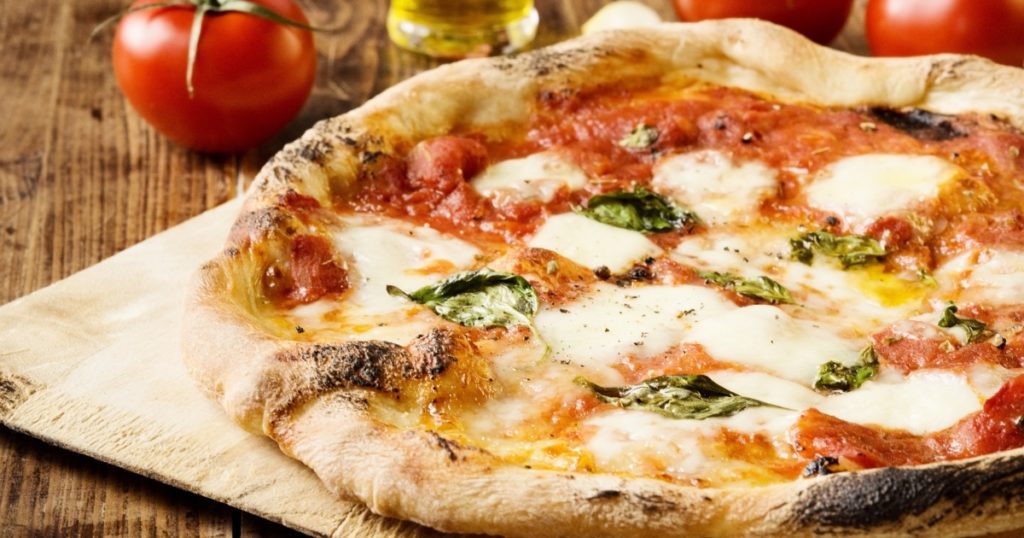
A Neapolitan pizza takes the classic Margherita to the next level with extra sauce and cheese. This pizza comes from Naples, Italy, and is famous for its thin, tender crust. It’s usually covered with San Marzano tomatoes, fresh mozzarella, basil, salt, and a drizzle of extra-virgin olive oil.
This pizza is baked in a wood-fired oven at high heat. The result is a beautifully blistered crust and a deliciously smoky taste.
According to Pizza Bien, a pizza can only be considered a true Margherita if it meets four main criteria, as outlined by the Associazione Verace Pizza Napoletana:
- You may use only San Marzano tomatoes.
- You can use only fresh mozzarella. The mozzarella must be made from water buffalo milk or a mix of cow and water buffalo milk. This specific type of milk is chosen for the rich, creamy texture and taste it imparts to the cheese.
- The dough must be expertly prepared using only flour, yeast, salt, and occasionally sugar and beer.
- The pizza must be cooked in a wood-fired oven at approximately 900 degrees Fahrenheit. It is a process that takes just 60 to 90 seconds.
These strict guidelines ensure the preservation of the authentic Neapolitan pizza’s traditional essence.
Different Kinds of Pizzas to Make 5: Chicago Deep Dish Pizza

Out of the different types of deep dish pizza, Chicago Deep Dish pizza is one of the most well-known ones.
Originating in Chicago in 1943, It features a thick, buttery crust that lines a deep pan, creating a deep dish. The pizza is assembled with toppings such as Italian sausage, onion, peppers, and mushrooms, followed by a layer of fresh mozzarella cheese and chunky tomato sauce. Due to its thickness, Chicago deep pizza requires a longer baking time in the oven.
This style of pizza has become synonymous with Chicago and is celebrated for its hearty and indulgent nature. Oh, and this pizza’s indulgent nature and meaty flavors demand the use of a knife and fork for a better dining experience. We’d definitely call it one of the best dinner ideas (or lunch)!
Different Kinds of Pizzas to Make 6: California Pizza

California pizza is a style of pizza that originated in California, United States. It blends influences from New York and Italian thin-crust pizzas with toppings inspired by California cuisine. Adventurous eaters will love its creative pizza toppings such as barbecue sauce, bbq chicken, avocado, sun-dried tomatoes, and goat cheese. Some makers even add spinach, artichoke hearts, and peanut sauce.
It is often baked in a wood-fired oven or on a pizza stone. It can be served with either thin and crispy pizza crusts or thicker and chewier ones.
Different Kinds of Pizzas to Make 7: New York-Style Pizza
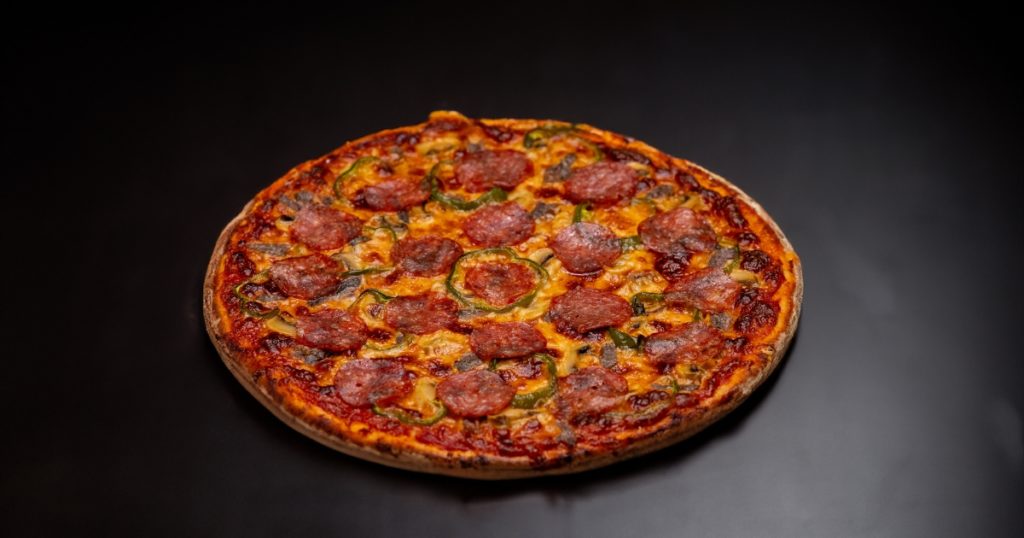
New York-style pizza is all about big, foldable slices with a thin, slightly chewy crust. Pizza makers toss it by hand and top it with tomato sauce and stretchy, low-moisture mozzarella. You can jazz it up with extras like pepperoni, mushrooms, or sausage. Baked in a gas oven, it gets a perfectly crispy yet bendy crust.
This pizza came to life when Italian immigrants hit New York City in the early 1900s. The dough’s made with high-gluten flour, a bit of sugar, olive oil, yeast, and water, giving it a unique taste and texture. The sauce? It’s a seasoned mix of tomatoes, garlic, and herbs, slathered over the crust before adding cheese and other toppings. And if you like, sprinkle on some garlic powder, red pepper, oregano, or Parmesan after baking.
Different Kinds of Pizzas to Make 8: Mushroom Pizza

Mushroom pizza is a classic choice for pizza lovers who are looking for vegetarian recipes. It’s simple: a thin or thick crust topped with tomato sauce, lots of mozzarella cheese, and heaps of mushrooms. Whether you like your mushrooms sautéed first or thrown on fresh, they add a juicy, earthy flavor to the pizza that’s hard to beat.
This pizza is perfect for those who love a bit of nature’s bounty on their plate. You can stick to just mushrooms or mix in other toppings like onions, peppers, or different cheeses to make it your own. Bake it until the cheese is bubbly and golden, and you’ve got a delicious mushroom pizza ready to enjoy!
Which type of pizza is the most popular?
It’s hard to say which type of pizza is the most popular because everyone has their own favorite. With so many kinds of pizzas out there, from classic cheese and pepperoni to more unique flavors like Alfredo Pizza or Buffalo Chicken Pizza, it really depends on personal taste.
Some people love the simplicity of a Margherita, while others prefer the variety of a supreme pizza—and some even love pizzas with black olives. In the end, it really depends on who you ask. Everyone has their own favorite when it comes to eating pizza, that’s for sure!
Want to learn the different types of pizza to make at home?
Finished reading and feeling inspired for a pizza night at home? Why settle for delivery when you can craft your own perfect pizza, ensuring top-notch quality every time? That’s why homemade pizza is better—it’s simply unbeatable.
But where can you get recipe collections for homemade pizza? Well, you don’t have to go far. Just enroll in Chef Joey Prats’ newest class here at The Bailiwick Academy: Pizza Master Class Deluxe!
Enroll and get hands-on with these eight pizza styles:
- Cast Iron Pan Pizza
- Chicago Style Deep Dish
- Detroit Style Pizza
- New York Style Pizza
- Roman Style Pizza Bianca
- Sicilian Style Stuffed Crust with Vodka Sauce
- California Style BBQ Chicken Pizza
- Neapolitan Style Pizza
Just like all the classes at The Bailiwick Academy, it’s an easy-to-follow class, perfect even if you’re a beginner. You’ll not only learn to make these diverse pizzas but also gain skills that go beyond the basics. This class is your ticket to making the perfect pizza every night.
Soon enough, you’ll be on your way to starting a food business. Maybe it will even be one where you transport your baked pizza pie to your customers.
What are you waiting for? Sign up at The Bailiwick Academy today and start your journey to being one of the best pizzaiolos ever!
—
Keep coming back to The Bailiwick Academy blog for more cooking and baking tips, kitchen tricks, and much more!
]]>Not to worry! If you’re curious about this iconic dessert, you’ll be happy to hear that this article will dive into the world of fruit cakes and discover why it has become synonymous with a Christmas menu.
Let’s get started, shall we?
So…what is a fruit cake?
What are fruit cakes, indeed? At its core, a fruit cake is a rich, dense cake packed with dried or candied fruits, nuts, and spices. The ingredients are often soaked in spirits like brandy or rum, which not only adds a depth of flavor but also acts as a preservative.
The cake is typically made well in advance of Christmas, allowing it to mature and develop its complex flavors. A fruit cake can also come in different shapes. It can be a round cake or be presented as mini loaf cakes, depending on the cake pan used. Mini loaves are easier to serve—something to note if you’re having a lot of guests who love fruits and cake in one dish!
Where is fruit cake from?
The origin of fruit cake can be traced back to ancient Rome, where a simple version was made using barley mash, pomegranate seeds, raisins, honeyed wine, and pine nuts. This early version was more of an energy-rich food than a celebratory treat. Since it was easy to carry around and didn’t rot for a long time, it became a very popular snack for Roman soldiers, who called it “satura.”
During the Middle Ages, with the arrival of preserved fruits, honey, and spices, the fruit cake began to resemble what we know today. The Crusaders reportedly carried this durable, energy-packed cake on their journeys for the same reason as the Roman soldiers did: due to its long shelf life. The bakers at the time also added more fruit and nuts.
Fruit cakes were eventually brought to America by European colonists and became especially popular in areas with limited access to fresh fruit. And now, here we are: a world where fruit cake is looked for during Christmas and other special occasions, like weddings.
Why This Dessert Is Associated With Christmas
This is actually a pretty interesting fact in the history of fruit cake. In the 18th century, laws were passed to restrict the creation of the fruit cake (called as a plum cake back then) in Europe, as the cakes were considered as “sinfully rich.” They were only allowed to be created during the holiday season, especially since the ingredients to make this at the time were considered both rare and expensive.
So, it makes sense that fruit cakes became a special treat for big occasions, right? Especially for Christmas. But why exactly fruit cakes became a Christmas thing is a bit of a mystery. They were first made as a high-energy snack, not really for celebrations.
One interesting story is from Swiss Colony. They say that in England, people used to give fruit cakes to Christmas carolers, who were often not very rich. This might be one reason why fruit cakes got so popular for Christmas.
What are the ingredients in a fruit cake?
Fruit cake is known for its diverse ingredients, which can vary based on personal preference, the cake recipes being used, or regional traditions. However, the usual fruit cake recipe includes the following components:
- Dried Fruits: This is the heart of the fruit cake. Common choices include raisins, currants, sultanas, dried cherries, apricots, and cranberries. Any candied fruit like orange and lemon peel are also popular.
- Nuts: Almonds, walnuts, pecans, and hazelnuts are often added for crunch and flavor.
- Flour: Standard all-purpose flour is typically used as the base for the cake.
- Sugar: White or brown sugar is used to sweeten the cake. Brown sugar can give a deeper flavor and moistness.
- Eggs: Eggs are essential for binding the ingredients together and adding richness.
- Butter: Unsalted butter—not margarine—is commonly used for its flavor and for adding moisture to the cake.
- Spices: A mix of spices like cinnamon, nutmeg, allspice, and cloves adds warmth and depth.
- Leavening Agents: Baking powder or baking soda helps the cake rise.
- Liquor: Brandy, rum, or whisky is often used to soak the fruits and to brush on the cake for preservation and flavor. Non-alcoholic versions might use fruit juices like orange juice or apple juice.
- Extras: Ingredients like molasses, honey, or treacle can be added for extra flavor and color. Vanilla or almond extract are also common for enhancing the aroma.
The great thing about fruit cake is that it is highly customizable. You can adjust the types and quantities of fruits and nuts to suit your taste, and even play around with the spices and flavorings. The key is to balance the flavors and textures to create a cake that’s something you really like.
What is the shelf life of a fruit cake?
A fruitcake that is tightly wrapped with aluminum foil or plastic wrap can be stored for up to 1 month in a cool, dark pantry, 6 months in the refrigerator, and 12 months in a freezer. Some people even feel that older fruit cakes taste better because of the alcoholic content. Of course, if there are signs of spoilage such as mold or off-odors, make sure to discard it!
But why does fruit cake last long, exactly? Well, one reason is thanks to its high alcoholic content. Alcohol acts as a natural preservative which prevents spoilage.
As for the other factors, well, it’s the same answer for the question why is a fruit cake dry. Its high sugar content helps absorb moisture, reducing the risk of bacterial growth. The dried fruits in the cake have low water content, further inhibiting spoilage. The cake’s dense texture, achieved through slow baking at low temperatures, also helps in preserving it.
Interestingly, the same things that make fruit cake last a long time have also made it a bit of a joke. Its heavy texture and strong flavor, plus the fact that it seems to never go bad, have made people joke about it as a holiday gift that nobody really wants and keeps getting passed around. But even with this funny reputation, many people still love fruit cake for its special taste and its place in holiday traditions.
Tips For Making Your Fruit Cake At Home
Want to have a fruit cake for the Christmas season? Sure, you can buy, as there will be plenty for sale this time. But if you want to make one yourself so you can control the ingredients, appearance, taste, and so on (i.e. you saw a recipe you wanted to try), here are some tips to take note of:
- Start Early: Begin your fruit cake preparations early. The longer the fruits soak and the cake matures, the better the flavor.
- Customize Your Cake: Feel free to experiment with different fruits, nuts, and spices. Make your fruit cake a reflection of your taste.
- Low and Slow: Bake your cake at a low temperature for several hours. This ensures even cooking and a moist texture.
- Storage: Wrap the cake in alcohol-soaked cheesecloth, then in foil. Store it in a cool, dark place and periodically brush it with more alcohol.
Make A Truly Delicious Fruit Cake With The Bailiwick Academy!
As we mentioned, you might have a fruit cake recipe you want to try. Well, here at The Bailiwick Academy, we have a class that you should definitely try. What are we talking about?
We’re talking about Chef Joey Prats’ Opulence Unwrapped: The Holiday Cake Experience class!
In this class, you’ll learn to make a unique fruitcake that everyone can enjoy, even kids! Chef Joey has crafted a recipe that’s both traditional and fresh, perfect for the holiday season. You’ll get to experiment with different fruits, nuts, and even choose your preferred alcohol, or opt for a non-alcoholic version.
His course is packed with easy-to-follow video tutorials, professional baking tips, and a fool-proof recipe. Whether you’re baking for your family or thinking of selling, this class has you covered.
This class is a must-add to your recipe collections. So what are you waiting for? Sign up at The Bailiwick Academy and start your journey to making the perfect holiday cake—bring the joy of fruitcake into your home this Christmas!
—
Keep coming back to The Bailiwick Academy blog for more baking and cooking tips, kitchen tricks, and much more!
]]>Just in case you don’t know what I’m talking about… Well, I’m talking about these golden, moon-shaped treats that look like empanadas. Inside are mixtures of seasoned meat and spices that, believe me, are filling and delicious!
But sometimes, while biting into one, I think of many questions about it. For example, is it really Jamaican? And why is it yellow?
If you’re wondering the same things—or if you have other questions about it—you’re reading the right article! Read on to find out more about these savory treats.
When were Jamaican patties made?
First things first: Yes, Jamaican patties are, indeed, from the Caribbean nation of Jamaica. They came about when Jamaica was still under the control of British colonizers. The Jamaican patty is derived from Cornish pasties, an English meat-filled pastry that comes from Cornwall, England.
Of course, while these were introduced to Jamaica by the British, they eventually transformed, flavored, and spiced these pastries. As a result, they become classically Jamaican!
According to Wikipedia, Jamaican immigrants eventually brought the recipe for these meat pies to the US and other countries. And that’s how the whole world learned about the delicious Jamaican patties. Currently, they’re available as frozen or fresh treats in groceries and restaurants in the United Kingdom, United States, and Canada.
What’s inside a Jamaican patty?
A classic Jamaican patty is filled with seasoned ground beef. The beef is cooked down with a blend of spices such as curry, turmeric (also common in Middle Eastern foods), allspice, and Scotch bonnet peppers, the latter being the secret to its spicy kick. As the dish evolved and spread around the world, variations have arisen.
While the original recipe only had beef as the main filling, you can now see Jamaican patties being stuffed with chicken, lamb, seafood, and even vegetarian options like soy. No matter your dietary preference, you can now enjoy one—or more—of these!
What is the Jamaican patty crust made of?
The Jamaican patty has a light, buttery, soft, and flaky crust, which gives it a perfect contrast to the hearty fillings. And when you eat it freshly baked, you’ll have a great experience of it crumbling with each bite, revealing the delicious fillings inside.
One distinctive feature of a Jamaican patty that really sticks out is its crust with a yellow color. What makes Jamaican patties yellow? Well, that’s the result of turmeric or curry powder being added to the dough—and doesn’t the color make the Jamaican patty super memorable and iconic?
What are the flavors of Jamaican patties?
What do Jamaican patties taste like? Well, the combination of tender meat and robust spices creates a taste sensation that’s both savory and slightly spicy. This unique blend of flavors keeps people coming back for more.
Are Jamaican patties spicy all the time? As mentioned above, Jamaican patties can be spicy due to the inclusion of Scotch bonnet peppers, ground allspice, and other spices. However, the level of spiciness can vary depending on your personal preference and the recipe you use.
Are Jamaican patties snacks, or can they be full meals?
Jamaican patties are versatile and can serve as either a satisfying snack or a small meal, depending on your appetite. Many people enjoy them as a quick lunch or dinner option. While I personally enjoy them as movie night snacks, you can have them any time of the day if you so choose.
Making Jamaican Patties at Home
If you’ve ever wondered how to make Jamaican patties, you’re in for a treat. While the traditional recipe can be somewhat complex, you can attempt to recreate these delicious pastries in their own kitchens. It will be a fun culinary journey that allows you to customize the flavors to your liking—especially if you get a really good recipe!
Make Irresistible Jamaican Patties Here At The Bailiwick Academy!
What are the best Jamaican patties you can make? Well, I don’t have an answer for that—after all, taste is subjective. But what I do know is that here at The Bailiwick Academy, you can make some of the best you will ever taste!
How? Well, with Chef Joey Prats’ latest online class: Irresistible Jamaican Patties!
Believe it or not, Chef Joey loves Jamaican patties. He wasn’t happy with the local offerings here, so he went on and developed his own recipes. Chef Joey didn’t stop at a Jamaican beef patty recipe, though—he also went and made chicken and tuna variants.
And, of course, expect a crisp, tender, meltingly delicious crust with a vibrant gold color. Make one of these from Chef Joey’s class; he guarantees you’ll never buy another patty from outside again!
So what are you waiting for? Learn to make these delicious snacks in the comfort of your home. Sign up at The Bailiwick Academy today!
Oh, and as of this writing, Christmas is drawing near. Maybe these can be your food business offerings for bazaars and Christmas parties!
Final Thoughts
Jamaican patties are more than just another dish; they are a testament to the rich culinary heritage of Jamaica and its unique fusion with other cultures. Whether you savor them as a quick snack, a hearty lunch, or decide to make them at home, these flavorful pastries hold a special place in the hearts of food enthusiasts globally. Their vibrant yellow hue, spicy kick, and flaky crust make them memorable and iconic in the world of savory snacks.
As we’ve explored their history, ingredients, and variations, it’s clear that their global reach and adaptability make them more than just a treat—they’re a worldwide sensation. Whether you enroll in Chef Joey’s class or buy one from a store, the allure of the Jamaican patty is undeniable. So the next time you bite into one, savor its rich history, its fusion of flavors, and the love and craftsmanship that goes into making each one!
—
Keep coming back to The Bailiwick Academy blog for more kitchen tips, tricks, and much more!
]]>And you know the best part? You may already have the ingredients of some of these suggestions, so you can get started right away after reading this blog!
Excited? Well, without any further ado, let’s get to some decadent dessert ideas!
Decadent desserts meaning what, exactly?
When you call food decadent, what exactly does it mean? What does decadent mean in food?
Well, the term usually refers to food that is rich, luxurious, and indulgent. And that usually means the food is high-calorie, high-fat, and high-sugar – definitely considered things you shouldn’t be eating on a keto diet. So in short, to answer the question, “What are decadent desserts?”, they’re desserts that taste super good – but are also super unhealthy.
Decadent foods are usually associated with events that are lavish or celebratory, like holidays, special events, or romantic evenings (hello Valentines!).
How did decadent food come to be?
The story of this is actually quite an interesting one. According to Ehow.com, the “decadent movement” began in 19th-century France. Certain young and sophisticated people in Europe, for some reason, believed that civilization was, well, doomed.
And since everything was doomed, why not just make everything as pleasurable as possible, including food – even if it doesn’t make sense?
Well, as you read this, you’re probably already going, “Well, the word didn’t end!”, and you’re right. It’s just that a lot was happening back during that time, so we guess that’s why they thought that way.
Now, is “decadent” good or bad? Well, we would answer it really depends on your perspective. But one good thing about that movement is that the idea of decadent food was born. So now, we have food like chocolate truffles, truffle fries, foie gras, lobster bisque, and more!
Why should you build a decadent desserts menu?
You might be wondering why you would need to make a decadent dessert menu. Well, here are some good reasons, especially if you’re a food business owner.
You’ll have added appeal to your customers.
As mentioned earlier, decadent desserts are usually ordered for special occasions. That means if you have a menu that offers exactly that, you will easily appeal to your customers who are looking for something special – even to just cap off their lunch or dinner! A best desserts menu always gets the eye of people for sure.
You can use the decadent desserts menu to show off your skill and creativity.
When you offer decadent desserts, it means you have really special skills in baking. Show them off in your decadent offerings! Doing this also lets you explore and challenge yourself in coming up with new creations.
You will stand out from competitors.
Decadent desserts aren’t necessarily the norm, right? So if you offer them, your business will definitely stand out from your competitors. You’d easily attract customers who are looking for more than the usual fare.
Tips for creating a decadent desserts menu
Convinced to start making a decadent dessert bar menu? Here are some things to consider:
- When selecting desserts, try to think about what beverages or drinks you’re going to pair them with, such as coffee or dessert wines. These can enhance the dining experience and create combinations that will definitely be remembered. You can even upsell them when people purchase your desserts!
- Don’t just stick to one flavor or type (i.e. chocolates only). Offering a different range of desserts with varying levels of sweetness, richness, and textures lets you hit more than one palate and preference. And when you add flavors or ingredients, you also hit another level of interest and excitement, which means more customers!
- Remember to also experiment with plating or presentation. Try to go about it as if you’re offering the most decadent desserts in the world! That means going all out in terms of presentation for added appeal and an experience that customers will never ever forget.
What are examples to include in a decadent desserts menu?
To be honest, there are countless options to choose from. But to make things easier for you, here are five of our suggestions of some of the best decadent desserts:
1. Churros
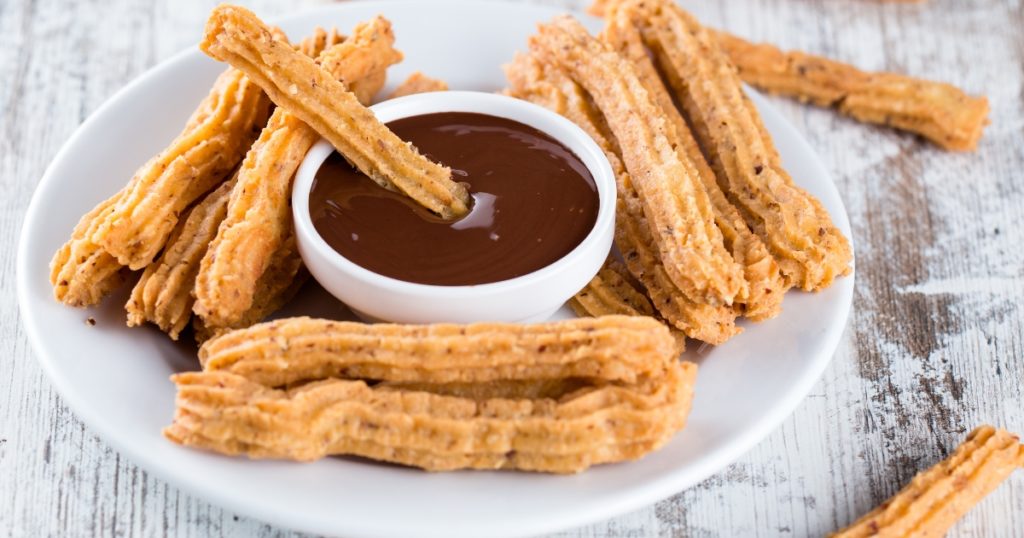
Churros are a popular dessert in Spain, Latin America, and several parts of the world. They are fried dough pastries that are made of delicious fried dough that are dusted with either cinnamon or sugar or even both. You can also see them in different shapes and sizes – knotted, thin, thick, long.
If that sounds decadent already, here’s something that makes it even better: you usually dip churros in a chocolate dipping sauce – making it a truly delicious and indulgent treat worth trying! Is chocolate decadent? It sure is!
If you feel like adding this to your decadent desserts menu, try out the Churros Con Chocolate class of Chef Joey Prats here at The Bailiwick Academy. It was born out of a frustration of not being able to find authentic churros in Metro Manila – so you can be sure that Chef Joey made it as authentic and as indulgent as possible.
2. Cheesecake
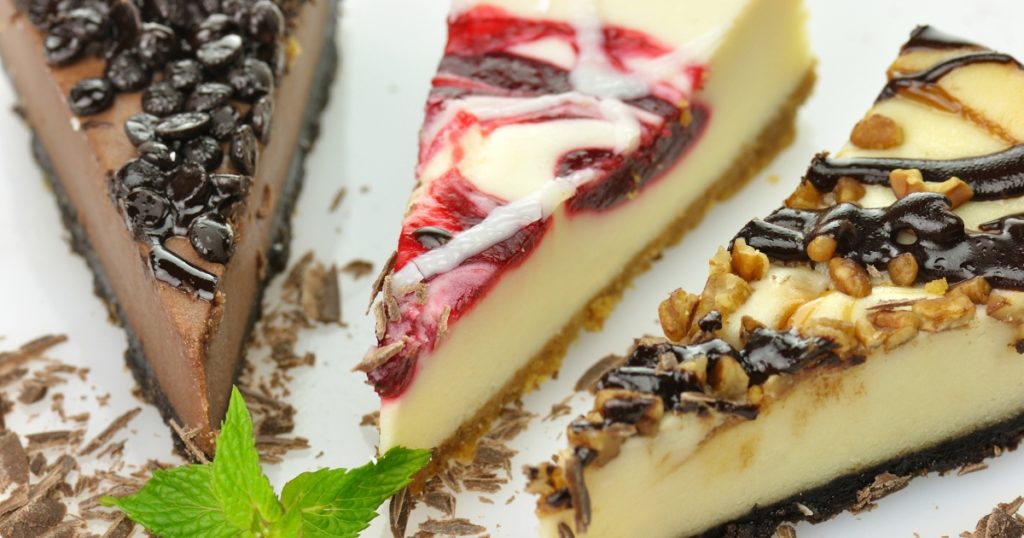
Cheesecakes are always a crowd favorite, but did you know they’re actually quite indulgent? Even the most classic, basic, New York-style cheesecake that has a graham cracker crust and a thick and creamy filling is decadent already. What more the other variations, especially when they’re topped with more delicious stuff?
And speaking of variations, you can get three of the creamiest, dreamiest, gourmet cheesecakes in the Luxurious Cheesecakes class by Chef Joey Prats – all pretty decadent, if you ask us!
3. Macarons

Macarons are delicate French cookies made from ground almonds, egg whites, and sugar, and filled with a creamy ganache or buttercream. They come in a variety of flavors and colors, and their crisp exterior and chewy interior make them a unique, delicious, and very indulgent dessert option.
Want to learn how to make not one, not two, but SIX variants of macaron that have the perfect look, crunch, and chewiness? Enroll in Parisian Macarons by Chef Joey Prats!
4. Crème Brûlée
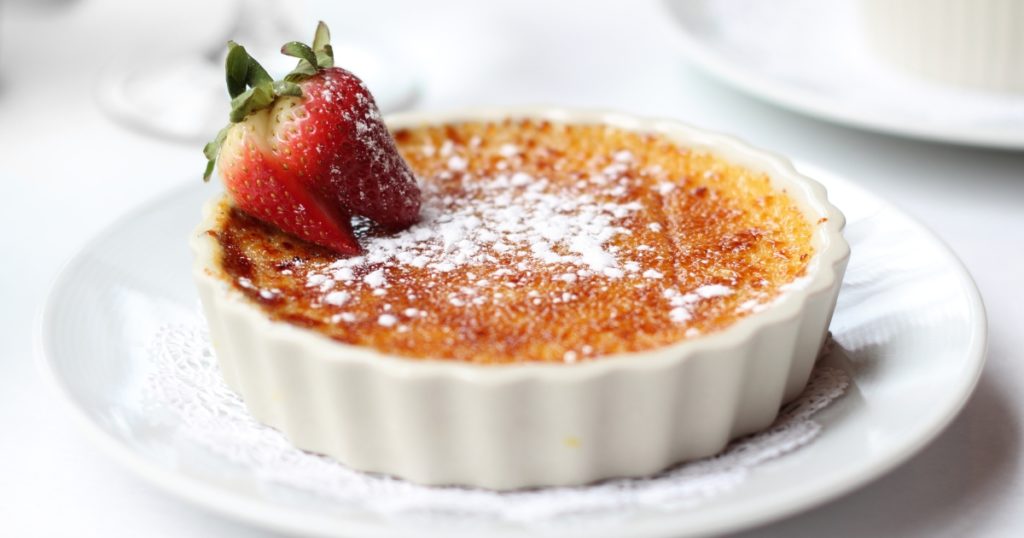
Spelling out this indulgent, decadent treat is hard, but appreciating its taste is not! This smooth and creamy vanilla custard topped with a layer of crunchy caramelized sugar is luxurious and perfect for those who are looking for a treat that’s both creamy and sweet! It’s simple but is also one of the most decadent desserts in the world.
In fact, it’s so good, Chef Joey Prats featured this treat in two of his classes: The Cake Cannery and Special Celebration Cakes II! He makes both in cake form, effectively leveling it up!
5. Tiramisu
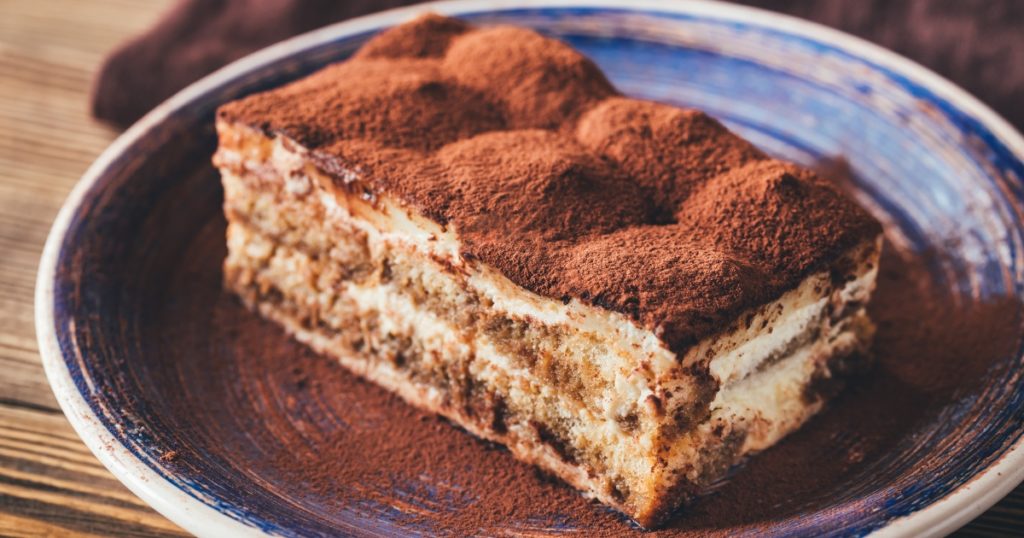
This Italian dessert is a heavenly combination of coffee-soaked ladyfingers and a mixture of mascarpone cheese, eggs, and sugar. Dust the top with some cocoa powder, and you get a heavenly, decadent dessert that is sure to satisfy any sweet tooth!
If you’re looking for a surefire decadent recipe, check out this class: The Cake Pannery by Chef Joey Prats!
Here’s one more item to include in your decadent desserts menu
Notice something about all those decadent desserts we mentioned? They all have versions or recipes by Chef Joey Prats. And if you know Chef Joey, you’d know he’s a lover of all decadent food.
That’s probably why he transforms even ordinary, humble fare into extraordinary ones. The best example? His ensaymadas: they’ve been called “the Rolls Royce of ensaymadas” by FOOD Magazine for good reason!
And if you want to learn how he does it in person, and these luxurious treats to your menu, then we’re inviting you to join us for this very special, FACE-TO-FACE LIVE class: Deconstructing Decadence!
This is happening on March 25, 2023, at Kessler’s Kitchen in Sta. Rosa Laguna. And in this class, you’ll not only learn to make the lightest, fluffiest, and most alluring ensaymadas ever, you’ll also get to take home plenty of good stuff, such as access to the recipes, and loot bags from our sponsors.
Plus, even if you’ve already taken his Artisan Ensaymadas class, Chef Joey will be releasing two new flavors that no one has ever tasted before! So those are added flavors to your menu instantly!
And ensaymadas are definitely good for a food business: one of our success stories, Joanna Cabrera, used ensaymadas to grow hers!
Excited to enroll? Tickets are limited though – only 40 students are allowed!
So if you really want to learn how to make decadent ensaymadas – and so much more – make sure to buy your ticket today! Click here to reserve your slot at Deconstructing Decadence!
—
Keep coming back to The Bailiwick Academy blog for more kitchen tips, tricks, and much more!
]]>If not, well, let me tell you: you’re missing out on a lot!
Let me tell you, there’s a reason why it’s priced that way… and why Food Magazine declared his artisan Ensaymadas as the “Rolls Royce of Ensaymadas” back in 2016 – it’s SO GOOD!

Of course, there’s more to Chef Joey than just his ensaymadas. If you’re a fan of delicious and indulgent desserts, you’d want to know more about this amazing chef.
Curious about his teaching and cooking? Well, a blogger calls all his recipes “to die for”, and well, here’s what Bailiwickers have to say about him:

Want to know more? Well, without further ado, let’s take a quick look at one of the most beloved expert chef instructors at The Bailiwick Academy, shall we?
Who is Chef Joey Prats?
Now, Chef Joey Prats is a highly-accomplished chef, so to even summarize his achievements is hard, but we’ll try. Here we go!
Chef Joey is a highly distinguished pastry chef and baking consultant who started baking at the age of 12. He apprenticed in the Attic Inn, a family-owned restaurant, under the guidance of his mother Myrna Prats, herself a very-well known chef.
Chef Joey earned the distinction of being the Philippines’ youngest Executive Pastry Chef at the age of 20 while working in the Hyatt Terraces Baguio’s kitchens. And after he graduated from Saint Louis University with a Bachelor’s Degree in Commerce and Business Administration, he traveled to New York City to further his education.
He got an Associate Degree in Baking & Pastry Arts from The Institute of Culinary Education (formerly known as Peter Kump’s New York Cooking School).
And from there, let’s just say he has done a lot, such as (in no particular order):
- Being one of the people who trained and mentored Chef Miko Aspiras and Chef RV Manabat, two of our TBA instructors
- Worked in different capacities for various restaurants and culinary schools such as Golden Bakery Inc., Puratos (Phil) Inc., The Mario’s Group, Rich’s Products Corporation (New York), Center for Culinary Arts Manila, De La Salle – College of Saint Benilde, The Culinary Institute of Aristocrat, The Embassy of Chocolate (Indonesia) and more
- Has established the Joey Prats Group of Companies – a holding company that houses 3 of his subsidiaries: the Joey Prats School of Baking & Pastry Arts, Joey Prats Ultra Mixes, and Luxury Sweets by Joey Prats, or now known as Froey’s Bakeshop Specialties.
- Various cooking and baking demos such as this one and this one
- Written columns for Food Magazine like this one
Pretty impressive, wouldn’t you agree?
How did Chef Joey Prats join The Bailiwick Academy?
No one knows about this story, but this is how I met Chef Joey Prats.
Back in 2017, I purchased his recipe eBooks. I was able to do all the recipes which were all good, but I wasn’t satisfied. Because I looked up to Chef Joey, I wanted to meet this amazing chef in person, pick his brain, and just soak in his wisdom!
So you know what I did? I attended his face-to-face class in Paranaque back in April 2017. After the class, I approached Chef Joey and asked him to be one of the instructors at The Bailiwick Academy.
Here’s something you should know: The Bailiwick Academy wasn’t even established yet! But yes, I asked Chef Joey anyway. Hey, you miss one hundred percent of the shots you don’t take, right?
But if you predicted that he would say no, you’re absolutely right. And it wasn’t even once, it was twice!
But after so many follow ups (seven to be exact), Chef Joey finally said yes to featuring one of his classes: The Artisanal Ensaymada. After that, the rest is history! Chef Joey’s classes here at TBA are now 40, with more to come!
Who knows if he would have joined if I wasn’t persistent, right?
What are some of Chef Joey’s classes?
Do you know why Chef Joey Prats’ classes grew to that amount? My theory is that it’s because some of his classes are the top best-selling classes at TBA – and that makes Bailiwickers just want to learn more from him!
Some of his top sellers here are the Artisan Ensaymada class:
And Ube Jam!
All these have good reviews from our students. See more of his courses – click here!
Quick lessons from the master chef
One thing I and many other people really LOVE about Chef Joey is that aside from him being an icon in the baking and pastry industry in the Philippines is that he’s a really great teacher! An example here is when a student tagged him inside The Bailiwick Academy Student Lounge asking for help:
He immediately responded with this:
And because he’s an amazing teacher, it’s kind of hard to summarize his various nuggets of wisdom in one blog post. In fact, every time we have him as a guest on our various LIVE sessions, they usually end up going for more than an hour!
Like the time we had what we called Sweet Talk with Chef Joey last year. There were so many value bombs he dropped especially for people who want to get into the food business. I’ll summarize the five major ones, in no particular order:
1. Focus on one product.
When starting out in your food business, it’s best for you to focus on just one product at a time. That way, you can go full blast making it, up to the point that you perfect it and become known for it.
The best example? Chef Joey, of course, with his artisan ensaymadas! Obviously, you know he’s more than capable of cooking and baking different kinds of food. But for some holidays, he has chosen to focus on his version of this pastry.
And this tip is related to number two, which is:
2. Don’t put too many items on your menu.
You know another reason Chef Joey only wants to focus on his ensaymadas? Well, having too many menu items can be overwhelming for you, especially if you’re just starting out. The end result is that you may find yourself with items that are not as prepared well.
Also, it can overwhelm your customers with them having a hard time making a decision about what to buy first. And they won’t be able to associate that product with you, which is helpful for marketing purposes.
Focus on a small, well-curated menu when you’re starting out.
3. Do your projections early.
Did you know that your product pricing should be flexible – but in a way that helps you out? You see, when you buy ingredients from your suppliers, they won’t keep their prices the same all the time. You have to be ready for them to increase your price – and for yours to increase too.
As much as you want to keep your prices the same, can you really afford to not make a profit with your products when running a business? According to Chef Joey, that’s not a good business practice!
4. Choose products that have long shelf lives and are logistically friendly.
Here’s one thing to help you choose a product to sell: sell something that will last a long time (like his Best Ever Cookies) and something that will stay together even if it’s being transported. That way, you won’t be worried if you need to hire a motorbike or other delivery service and you end up with a driver who’s not a careful driver.
Also, on the off-chance that you encounter a bad day and you only have a few sales, or someone orders from you but is a scam, at least you know that your products won’t spoil right away. You can sell them at a lower cost or something.
5. Treat all your customers well.
This goes without saying, but whoever your customer may be, be sure to treat them well. Don’t discriminate whether they’re celebrity customers or regular ones. Always make sure you give them the best service possible.
Once they become your fans, you might find that they’ll be the ones bringing more customers to you!
Of course, there can be difficult clients, but we’d need more context into how to deal with those.
For more amazing business lessons, make sure to watch Chef Joey’s other videos on The Bailiwick Academy’s Facebook page and YouTube channel!
What’s next for Chef Joey Prats?
Well, you can be sure a chef as busy, as well-known, and as good as Chef Joey will always have plenty of projects scheduled. But as for The Bailiwick Academy, well, you can always expect him to come out with many more courses that will help you turn your passion for baking and cooking into profit!
If you haven’t yet, make sure to enroll in Chef Joey Prats’ courses here.
And if you want the chance to see him demonstrate one of his delicious recipes LIVE and IN-PERSON, make sure to join us at The Bailiwick Academy’s 5th year anniversary!
Not only will you get to talk to Chef Joey, ask him all the questions you want, and see his techniques personally…
But you’ll also get to TASTE his creation when he’s done, as well as take home loot bags that The Bailiwick Academy team has compiled for attendees. I’m sure you’re going to love the goodies inside!
Oh, and did I mention there’s going to be a raffle? And that you’ll get the chance to take home amazing prizes?
And before I forget, not only will you get to talk to Chef Joey and experience his baking, but you’ll also get a recording of his live demonstration. It’s like you paid for one of his courses here at TBA!
Slots are limited to the anniversary though – make sure to get your ticket at the TBA shop!
Chef Joey and I would love to see you there – so… see you there, I hope!
In the meantime, make sure to sign up at The Bailiwick Academy if you haven’t yet and experience our world-class courses!
—
Keep coming back to The Bailiwick Academy blog for more kitchen tips, tricks, and much more!
]]>Let’s take a closer look at what a French baguette is, and how to eat it, shall we?
What is a baguette?

So, first things first. How do you define a baguette?
Well, a baguette is a long bread loaf closely connected to France. How does a standard baguette measure, you ask? Well, apparently its diameter is about 5 to 6 cm or about 2–2+1⁄2 inches, while the usual length is around 65 cm or 26 inches.
However, there are also cases of a baguette measuring up to 1 meter or 39 inches long. Now that’s a baguette we would like to get our hands on!
Baguettes have crisp crusts and chewy textures inside. That’s what makes it distinct from other French breads (in case you’re wondering about French breads/French rolls VS baguettes).
According to Bakerpedia, no one is really sure where baguettes came from. However, the general explanation given is that it was first made in Vienna as an adaptation of another kind of bread.
The baguette became popular when the French government instituted that bakers should not work before 4 in the morning. That meant bakers found it impossible to make the usual round bread loaves for breakfast and had to resort to baking baguettes since they baked faster.
And in case you’re wondering if we were exaggerating about the connection of this bread and France, well, you should know that France is seeking UNESCO heritage status for the baguette. It’s kind of like what Singapore did for hawker food. So yes, even France finds their own bread iconic and a good cultural representative.
French baguette VS Vietnamese baguette: what’s the difference?
If you look closely at the baguette, you’ll see that it resembles the bread of the Vietnamese sandwich banh mi. Is the bread the same or not?

Well, they may look the same, but there are subtle differences. According to Full of Plants, the banh mi is very light, with a candy floss-like inside. The crust is also super thin and crispy, as you can see from the cracks.
As mentioned above, the baguette has a crisp crust and a chewy texture, making it thicker and heavier than the banh mi.
Another difference according to World-Grain.com is how the breads are made. The methodology of making French baguettes involves gentleness, while Vietnamese baguettes are made with lots of speed, noise, and high energy.
That makes these two breads very different from one another, despite similar appearances.
How to eat a French baguette: eight ways to try!
Now that we know what French baguette bread is, how to eat one is the next question. We’re not going to answer how do the French eat a baguette, though. Believe us, they have specific ways.
Instead, let’s focus on what you can do with this delicious bread, or more specifically, how to serve a French baguette.
1. By itself

How do you eat a French baguette? Well, one of the best things you can do is just eat it as it is, especially if it’s freshly baked. That’s how to eat baguette like the French: bite into a piece and get some nutty, buttery, sweet and savory tastes all at once!
A good baguette is one that is irresistible and makes it very hard for you to arrive home with either end in one piece.
2. With added flavoring

If you’re wondering how do French eat a baguette, let us tell you that a lot of them eat it plain. However, plenty of them also add additional flavoring to this bread! Some spread butter, jam, or Nutella before taking a bite for breakfast.
You might even find some French people dipping a piece of the bread into their coffee, just like what plenty of us do.
If you’re feeling fancy, you can also mix olive oil and balsamic vinegar to make a dip for your baguettes. It’s a delicious dip that goes very well with the flavor of the baguette.
3. As bruschetta
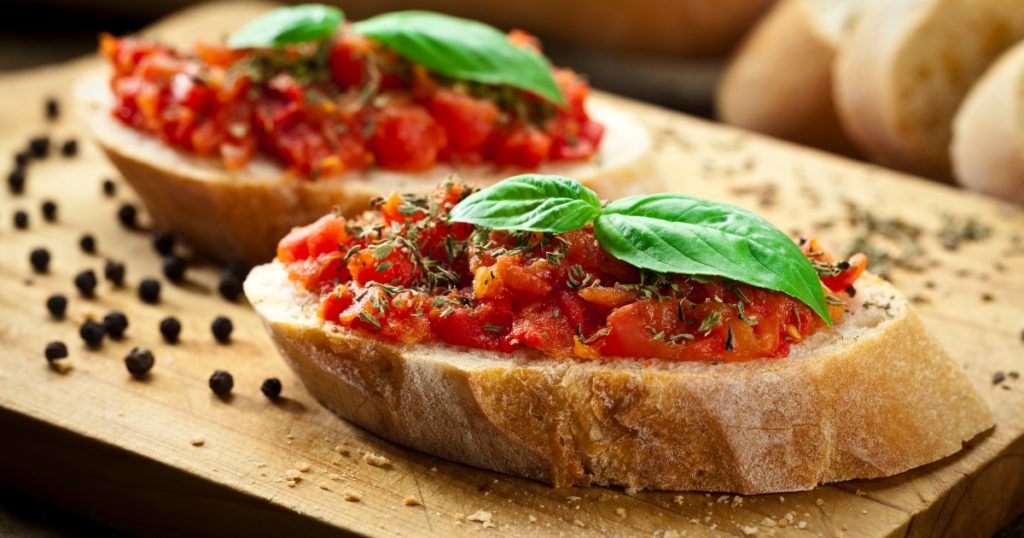
Bruschetta is a starter dish of Italian origin (ooh, like Italian 00 flour). To make it, you’ll get tomatoes, basil, garlic, and olive oil, and place them all on top of a toasted piece of baguette. You’ll love all the flavors in your mouth – it’s like a party!
4. As garlic bread

Here’s another idea of what to eat French bread with. Garlic bread can serve as a delicious appetizer, but you can also use garlic bread to further enhance any meal, like eating garlic bread with spaghetti. Put cheese, garlic, and herbs on top of the baguette, toast, and eat!
5. As a sandwich

Do you know what’s fun about making a sandwich? You’re in control of what to eat with a French baguette! Get your favorite toppings together, slice the baguette halfway open, and start making your delicious dream sandwich.
6. As croutons (when you have a stale French baguette)
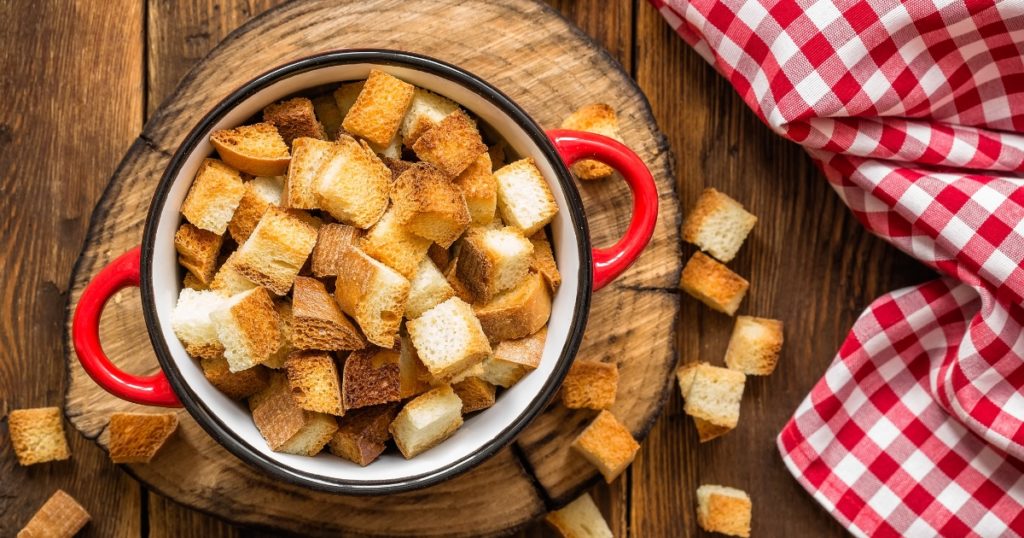
How long is a french baguette good for? Well, for a fresh one that’s not in the ref, 2 to 3 days. And if you have any leftover stale bread, why not make croutons?
They’re about the easiest thing you can make. And since you’re making them at home, you can customize the size, texture, and seasoning.
If you have croutons, you already have one answer to the question of how to eat a French baguette with soup. Yes, we know it’s totally random. You can also use croutons to add texture and flavor to salads, or as snacks.
7. As bread pudding
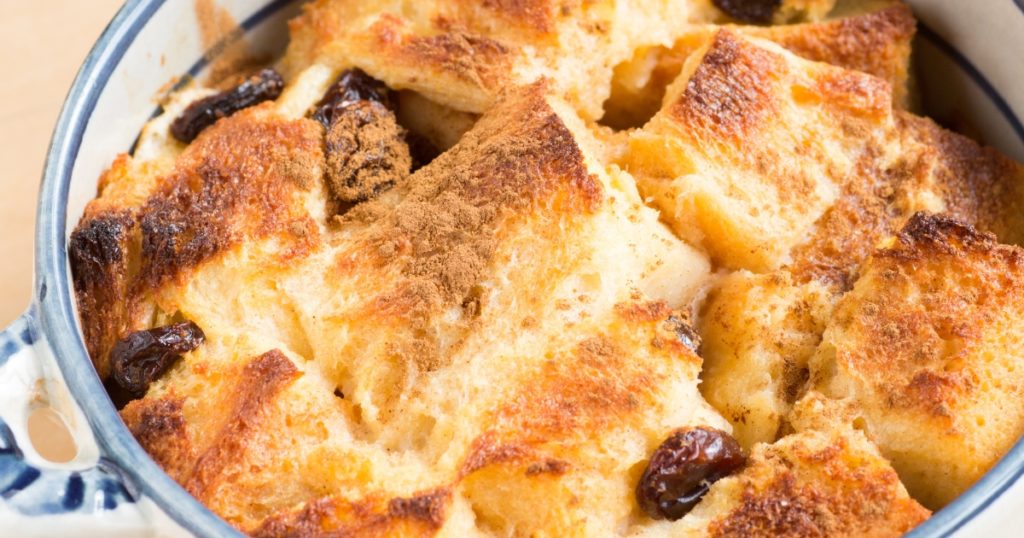
If you don’t want to make croutons with your stale French baguette, you can make bread pudding instead. It’s delicious, sweet, and an easy-to-make dessert with basic ingredients, so don’t waste your stale baguettes and make this instead!
8. As French toast
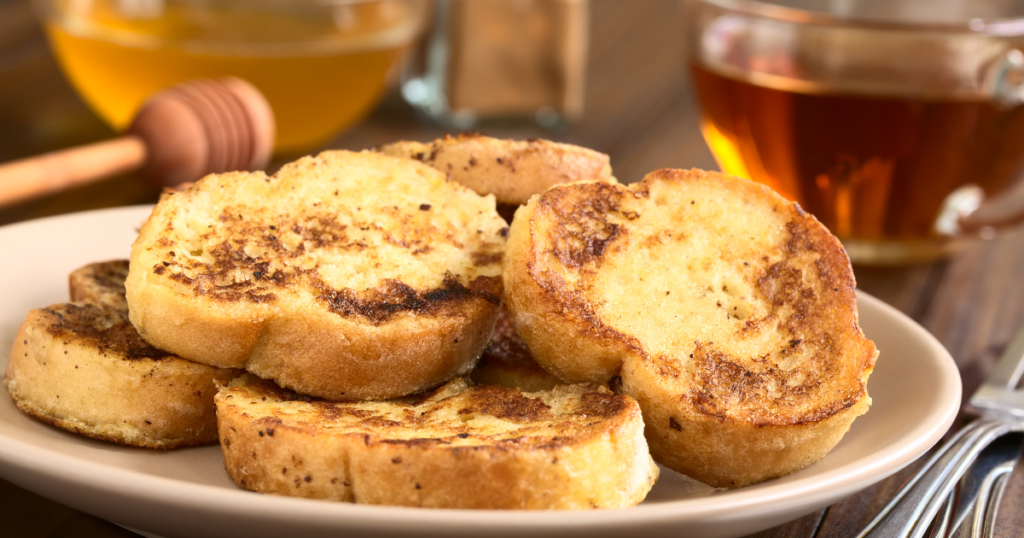
We can’t let this blog about a French bread end without a mention of French toast. Got it, got it?
Ahem.
Corny jokes aside, French toast consists of usually slice bread soaked in eggs, milk, and cream, then fried in a pan. If you plan to serve it as something sweet, you can add sugar, vanilla, or cinnamon.
However, there’s also a French toast variant that’s savory. You can make this and serve with salt, pepper, and mayonnaise or ketchup.
Now, to answer the question “Can I make French toast with a baguette?”, the answer is a big yes.
How to make French toast with a French baguette, you ask? It’s simple. Just substitute the normal sliced bread with a French baguette, and you’re good to go!
This might even become your favorite breakfast food – we never know!
Where’s the best place to get a French baguette?
If you’re looking for the best French baguette in the Philippines, well, we have some bad news for you. There’s no authentic French baguette anywhere except in France. You’re really going to have to fly over there – and that can be pretty expensive just to satisfy your craving!
But if you really want to eat a baguette (and get the closest French taste possible), you don’t need to look far. We recently launched a class with Chef Joey Prats: Classic French Baguettes!
This class will give you the best recipe for French baguette you can possibly find here in the Philippines. You’ll be able to produce a baguette that’s very close to the classic French version. That means you’ll be able to get bread that has a deep, golden brown crust with its distinctive “ears”; a cream-colored interior with a soft, airy, and light crumb structure filled with irregularly shaped holes; and finally, one super delicious aroma!
With Chef Joey’s recipe, you’ll also get a bread with a more complex flavor, a stronger structure, and one of the most important things in any food: an extended shelf life!
And as you just read above, baguettes are very versatile! Our list is just a taste of what you can do with them. The possibilities are endless, and that means baguettes will be able to mesh well with your current food business menu.
So what are you waiting for? Sign up at The Bailiwick Academy and learn how to make a proper French baguette – or at least, the closest you can possibly get!
—
Keep coming back to The Bailiwick Academy blog for more kitchen tips, tricks, and much more!
]]> (@greatbritishfood)
(@greatbritishfood)